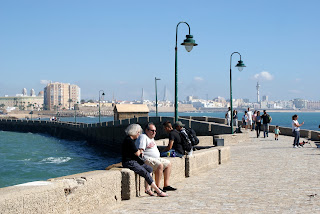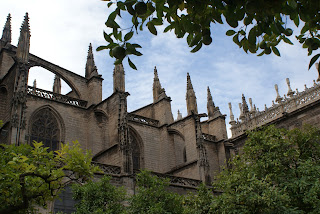 |
| Typical narrow street |
 |
Our breakfast cafe next to the church where the
Spanish constitution was signed |
Our legs could have done with a slightly longer rest than the 90 minute train journey south from Seville. In no time at all we arrived in the ancient city of Cadiz in south west Spain. It stands on a peninsula jutting out into a bay and is almost entirely surrounded by water. It was founded by the Phoenicians in 1100 BC and is the oldest continually inhabited city in Spain and one of the oldest in western Europe. The city became a wealthy trading port and in the 16th century was the home of the Spanish treasure fleet. Sir Francis Drake, Queen Elizabeth I's favourite pirate, took many riches from the Spanish as well as famously raiding Cadiz in 1587 at the Battle of Cadiz which delayed Spain's so called invincible Armada. We loved the immediate laid back and easy going feel we got as we trundled through the maze of ancient narrow streets with our bags looking for our characterful family run hotel. Having dumped our luggage our host pointed us in the direction of the tapas bar just across the street for some much needed refreshments. He also proudly told us that this was where Spain's first constitution was signed in 1812.
 |
| Fishing from the sea wall |
 |
| Plaza de San Antonio |
 |
| Plaza de Mina |
Thankfully the weather had returned to its usual glorious self and we decided to enjoy a walk round the old town. We took our time getting our bearings and once we had worked out whether we should turn left or right on leaving our hotel we were fine! Our first stop was the rather grand San Antonio Square. The Plaza was built in the 18th century and is home to a number of mansions once occupied by the Cadiz upper classes. Located in the heart of the old town is the lovely Plaza de Mina, developed in the 19th century and originally the home of the Cadiz bourgeoisie. Next stop the sea with views across the Bay of Cadiz. We continued eastwards along the sea wall and came across the Park Genoves nestled between the historic old town and the Atlantic ocean. It is a garden oasis full of many different species of trees and some exotic topiary. Our journey took us past the striking contemporary hotel, Parador de Cadiz, a little outside our budget, and then into the Castle of Santa Catalina before we returned to our hotel for a well earned rest before our night out on the town at La Perla Peña Flamenca club .
 |
| Exotic Park Genoves |
 |
| Ofelia Marques performs at La Perla Peña |
Cadiz is one of the areas in Spain where Flamenco began and we had an unforgettable evening at La Perla Peña. The flamenco peñas give a more traditional insight to flamenco, and they are normally run by aficionados of the art whose main aim is the flamenco, and not how much they can make from tourists. We grabbed a drink and were ushered into the packed hall and to two seats at a table right in front of the stage. We were joined by a couple of Spanish girls who were down for the weekend from Madrid and an American lady who was starting up women only tours to Guatemala and Andalucia!
 |
| Plaza San Francisco |
 |
| View from the Torre Tavira |
 |
| Barrio de la Viña |
 |
| Anyone for oysters? |
 |
| La Caleta beach and promenade |
We set off early the next morning for a taste of local life and a mooch around the busy fish market. We resisted trying the delicious looking fresh oysters with lemon being sold on the street corners and instead opted for a coffee next to the fragrant flower stalls. For something different we climbed to the top of one of the original city watchtowers, The Torre Tavira, for great panoramic views and a fascinating darkened room. This room is the home of a camera obscura, an ancient form of pinhole camera and a great way of spying on your neighbours without being seen! For lunch we found our way to the historical La Viña district of the city. We were not in search of wine but the well known and extremely popular El Faro fish restaurant and its tortillitas de camarones (shrimp fritters) which did not disappoint. In the afternoon we walked in the footsteps of 007 past pretty La Caleta beach and along the causeway to the Castle of San Sebastian. Cadiz is often likened to Havana, Cuba, and was used as such in the James Bond movie Die Another Day.
 |
| La Caleta beach and Santa Catalina castle |
The causeway leading to San Sebastian castle
The cathedral and Plaza de la Catedral
 |
| Forty winks! |
 |
| Plaza de San Juan de Dios |
 |
| Cadiz city gate |
Most disappointingly our cafe across the road was closed for our Sunday breakfast so we were forced to pastures new for our morning coffee and toast. We decided to check out the large Plaza de San Juan de Dios, the commercial centre of Cadiz since the 16th century due to its proximity to the harbour. Cadiz is an architectural delight full of historical monuments. As we wandered the streets we discovered churches, palaces, and colourful buildings, some dating back to the middle ages. Rejuvenated after another delicious meal we went in search of some indoor delights. We found ourselves back in Plaza de Mina exploring the Museum of Cadiz which houses a mixture of archaeological and fine art treasures. We had a wonderful few days in this fascinating, friendly and cheerful city and can't wait to go back.


















































